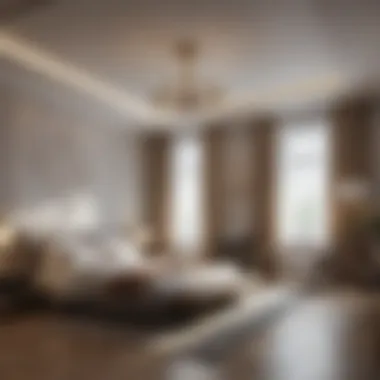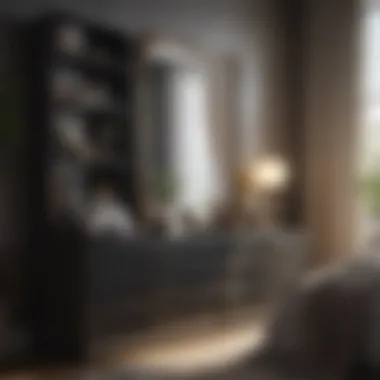Mastering Bedroom Organization: Declutter Your Space


Intro
In the realm of domestic serenity, the bedroom stands out as the ultimate sanctuary for many. Yet, as life unfolds and we accumulate belongings, this serene space can gradually morph into a cluttered chaos. By addressing this clutter, not only can one rejuvenate the aesthetic appeal of the room, but also create an atmosphere rife with tranquility and focus. Mastering bedroom organization is not just about aesthetics; it cultivates a mindset that embraces clarity and calmness, reducing stress and promoting mental well-being.
Understanding the psychological benefits of a well-organized space can motivate even the most reluctant individual to tackle the overwhelming task of decluttering. A clean and orderly bedroom can positively influence mood, enhance sleep quality, and arguably can even streamline daily routines.
Embarking on this journey involves several key steps:
- Assessing the current state of the bedroom.
- Implementing sorting techniques tailored to preferences and lifestyle.
- Harnessing clever storage solutions to maximize space.
- Maintaining order to ensure longevity of the system put in place.
By focusing on practical details and personal style, one can transform a potentially stressful process into an enjoyable endeavor that speaks to one’s identity. Let's dive deeper into the strategies that can help you reclaim your bedroom as a haven of peace.
Design Inspirations
Creating an organized bedroom isn't just about the how; it also encompasses the feel and aesthetic one wishes to achieve. Inspiration is everywhere, and tapping into the latest design trends can lead to a beautifully organized space.
Latest Trends in Bedroom Design
Minimalism is in vogue, with many opting for cleaner lines, uncluttered surfaces, and functional furniture pieces. Yet, minimalism doesn’t mean stark or cold; indeed, it's possible to warm these designs with personal touches, cozy textiles, and vibrant accents.
Colors play a pivotal role in establishing mood and ambiance. Softer hues tend to create a more soothing environment, whereas bold colors can infuse the space with energy. Balancing these elements is key to achieving a harmonious atmosphere. Consider some options, such as:
- Soft pastels for a calming vibe.
- Earthy tones to ground the space.
- Bright accents that showcase personality.
Color Palettes and Themes
The color scheme you choose can influence emotional responses and interactions within the room. For example, soft greens and blues bring a sense of calm and promote relaxation; meanwhile, warm yellows and reds can enhance creativity and energy.
Personal preferences come into play, making the space feel distinctly yours. When selecting colors and themes, think about what environments typically bring you peace.
"The way a room looks affects how it feels; and it's often overlooked in our quest for function. Finding a balance is the art of bedroom organization." – Anonymous
Functional Elements
Design must also be functional, particularly in the realm of bedroom organization. It's crucial to optimize space and make the best use of every inch without sacrificing style.
Space Optimization Tips
Consider assessing the bedroom's layout and reflecting on how you utilize the space. You'd want to establish a clear intention for various zones within your room. Here are some tips to optimize:
- Use vertical storage: Shelves, hooks, and cabinets can free up floor space.
- Repurpose under-bed spaces: Storage bins or drawers can neatly contain off-season clothing or rarely-used items.
- Declutter surfaces like nightstands and dressers to promote a sense of openness.
Multi-Functional Furniture Choices
Embracing furniture that serves dual purposes can work wonders in maximizing room utility. Think of a bed frame with built-in drawers, or a compact desk that can fold away. Such innovative designs allow for efficient use of space, all while keeping the bedroom stylish. Therefore, one can turn a common challenge into opportunities for neatness.
Combining design inspirations with functional elements lays the groundwork for a bedroom that is not only organized, but resonates with your individual style and preferences. This balance between form and function is essential in attaining a space that feels both inviting and clutter-free.
Understanding Clutter: The Impact on Mind and Space
Clutter in the bedroom isn't just a matter of aesthetics; it deeply affects our state of mind and overall well-being. An organized room often leads to a clearer mind while a disorganized space can feel overwhelming. This section serves to unpack the significance of understanding clutter, its psychological ramifications, and how a tidy bedroom can transform daily life.
Defining Clutter in the Bedroom
Clutter can be seen as a collection of items that not only take up space but also disrupt the harmony of your environment. Essentially, what does clutter look like in a bedroom? It could be anything from clothes strewn on the floor, a pile of unread books on the nightstand, or miscellaneous items that have no definite place. In simpler terms, if it doesn’t belong, or if it’s out of order, it’s clutter. Understanding what constitutes clutter is the first step toward managing it:
- Unwanted Items: Things that you no longer use or need.
- Incomplete Tasks: Items that remind you of things you haven't done yet, like mending clothes or returning library books.
- Surplus Accessories: Excessive knickknacks that serve no purpose can clutter visual space.
When you look at your bedroom and notice the clutter, remember it’s not just about physical space; it’s about the impact on your mental clarity and productivity, which leads to the next significant point.
Psychological Effects of a Cluttered Space
A cluttered bedroom can feel like wearing a heavy coat on a warm day—uncomfortable and distracting. It can stir feelings of anxiety or stress, making it hard to unwind after a long day. According to studies, people living in cluttered environments often report higher levels of fatigue. In fact, urban living can compound this effect, where homes often become a catch-all for hectic lifestyles.
"Messy environments create a sense of chaos that mirrors the inner turmoil many people experience."
Essentially, the clutter demands your attention, preventing you from focusing on what truly matters. It’s important then, to acknowledge how physical clutter can lead to mental clutter. Clearing out unnecessary items can prompt a sense of accomplishment and clarity, reducing anxiety and improving mood.
Benefits of an Organized Bedroom
The perks of maintaining an organized bedroom extend beyond just having a cleaner space; they contribute to a calmer and more focused life. When you manage to streamline your environment, here are some notable benefits:
- Enhanced Sleep Quality: An organized bedroom can lead to better sleep. A clutter-free space fosters tranquility.
- Increased Productivity: You’ll find it easier to focus when distractions are minimized.
- Reduced Stress Levels: Clearing out physical clutter can help clear mental fog.
- Improved Mood: The act of organizing itself can be therapeutic and can elevate your spirits.
An organized bedroom can serve as a sanctuary, a place where you can relax and recharge. Taking the time to address clutter impacts not only the space around you but also how you feel within that space.
In summary, understanding clutter is about recognizing what it does to our minds and our environments. By bringing awareness to this issue, we pave the way for meaningful changes in how we live and feel in our intimate spaces.
Preparation: Setting the Stage for Decluttering
Before jumping into the nitty-gritty of decluttering your bedroom, laying the groundwork is essential. Just like you wouldn’t build a house on sand, you shouldn’t start organizing without a solid plan. Proper preparation allows you to approach the task with clarity and purpose, increasing the chance of success. It’s not merely about tossing items into boxes or drawers; it’s about creating a space that reflects you while promoting peace of mind.
Creating a Decluttering Plan
A decluttering plan serves as a roadmap for the journey ahead. Start by assessing what you want to achieve. Do you want a more functional space, or are you seeking a serene environment for relaxation? Pinpoint your goals to ensure you're on the right path.
- List Your Goals: Make a note of your objectives, such as more organizing systems, or decluttering specific areas like your closet or nightstand.
- Break It Down: Divide the tasks into smaller, manageable sections. Instead of tackling the whole room, focus on one aspect at a time. It could be as simple as the nightstand or as complex as the entire wardrobe.
- Visualize Your Vision: Think about how the space should look after decluttering. Spend a moment imagining each area—this mental picture will guide your decisions about what stays and what goes.
Gathering Necessary Supplies
Once you have a plan in place, it’s time to gather the tools that will help you achieve your vision. Having the right supplies at your fingertips can make the process smoother and less daunting. Here’s what you might need:
- Boxes or Bins: Get various sizes for sorting items into categories—keep, donate, trash, and maybe.
- Trash Bags: You’ll eventually need these for items that can’t be donated but should be disposed of properly.
- Markers and Labels: Labeling boxes can add organization and clarity, saving you time later when you’re searching for specific items.
- Cleaning Supplies: Dust cloths, a vacuum, or any cleaning agent will ensure your space is sanitized and ready after decluttering.
Remember, having everything prepared beforehand helps you stay focused and avoid interruptions while decluttering.
Establishing a Timeline


Like many things in life, timing plays a critical role in decluttering. Establishing a timeline keeps everything running smoothly and prevents the project from dragging on indefinitely.
- Set Realistic Deadlines: Assess how much time you have to allocate to the project. Whether you want to dedicate a weekend or a week, be honest with yourself about what’s feasible.
- Schedule Regular Checkpoints: Create milestones—these could be completing a certain area or reaching a halfway point. Checkpoints help you evaluate your progress and adjust your plan if needed.
- Flexibility is Key: Life can throw curveballs. If something disrupts your timeline, don’t beat yourself up. Just adjust as necessary and keep moving forward.
The heart of effective decluttering lies in preparation. When you set the stage thoughtfully, you set yourself up for success.
By meticulously preparing for your decluttering journey, you embark on a path that not only simplifies your space but enriches your life. Take the time to thoughtfully consider and prepare each aspect, and you'll find the decluttering process transforming not just your bedroom but your mindset too.
Assessing the Current State of Your Bedroom
Understanding your bedroom's current state is crucial for effective decluttering. Before diving into sweeping changes, taking a step back to analyze the situation provides insight that can significantly ease the process. This phase allows you to identify what truly matters and what might be just taking up valuable space.
Here are some key reasons to assess your bedroom:
- Clarity on Clutter: This initial look enables you to recognize what items are contributing to the mess. You might be surprised by how much is unused or unnecessary.
- Set Priorities: Not all areas in your bedroom hold the same importance. By locating problem spots first, you can focus your energy on areas that have the most significant impact on your daily life.
- Personal Involvement: Reflecting on what is personally significant can fuel your motivation. This insight keeps you engaged as you move towards a more organized space.
Overall, this assessment stage is about empowering you with information that can lead to an organized bedroom you’re proud of.
Identifying Problem Areas
To pinpoint clutter hot spots, you may need to do a little detective work. Consider the following steps for effective identification:
- Walk the Room: Survey the space with fresh eyes. Notice where chaos tends to accumulate.
- Notice Your Routine: Pay attention to places that hinder your daily activities, like the side of the bed where clothes pile up or the nightstand that’s overcrowded with knick-knacks.
- Check Storage Areas: Look inside drawers and closets. Overflowing bins or items crammed together often signal trouble.
Once you identify these areas, it becomes clear what needs immediate attention. This focused approach can save a lot of time later.
Understanding Personal Preferences
Clutter isn't just about objects—it's also about what resonates with you. Understanding your personal preferences is vital in shaping an inviting bedroom. Consider the following:
- What Makes You Comfortable?: Your bedroom should be a sanctuary. Think about colors or decor that evoke calm and comfort for you personally.
- Disliked Items: Take stock of belongings that no longer align with your taste. Identifying what brings discomfort or irritation can illuminate choices for removal.
- Functionality: Think about how you use your space. If you love reading in bed, perhaps a dedicated nightstand would better serve your needs.
This part is about self-discovery within your own space; making sure your bedroom reflects who you are can transform it into a restorative environment.
Visualizing the Desired Outcome
Now that you have assessed the situation and understood what you enjoy, it is time to form a clear picture of what you want your bedroom to become. Visualization is more than daydreaming—it serves as a guide for your decluttering journey:
- Create a Mood Board: Collect images that represent the look and feel you desire. This can help clarify your vision.
- Set Achievable Goals: While dreaming big is great, remember to keep your objectives realistic. A stunning bedroom doesn’t need to be achieved overnight.
- Consider Function and Aesthetics: Your visualization should balance beauty and practicality. Think about how items should work together to foster both beauty and functionality.
By clearly visualizing your end goal, you create a strong foundation to navigate the decluttering process effectively.
"An organized space is a reflection of a mind at peace. Start with clarity—both in space and in thought—to carve the path ahead into a tranquil haven."
Engaging in this process transforms the daunting task of decluttering into a more manageable and even inspiring journey as you reshape your bedroom into a place that truly feels like home.
Effective Sorting Techniques
In a quest for an organized bedroom, effective sorting techniques serve as the backbone of a successful decluttering journey. These methods not only help in discerning what to keep and what to toss, but they also make the process less overwhelming. With countless items vying for your attention, having a strategy can simplify decision-making, thus amplifying the sense of achievement as each category is tackled. Employing systematic sorting techniques can also aid in retaining emotional well-being, ensuring that the process aligns with personal values and lifestyle choices.
The Four-Box Method
The Four-Box Method is a straightforward yet immensely effective approach to sorting through belongings. Here's how it works:
- Keep - For items you routinely use or absolutely need.
- Donate - For those that are still good but no longer serve a purpose in your life.
- Trash - Any damaged or unusable items that you cannot repair.
- Store - Items that are seasonal or not needed presently but have value for the future.
With this method, you literally have categories to place your items into, making the sorting process tangible. It also visually declutter spaces as you see items being categorized and cleared away. The physical movement of items can create an immediate emotional lift, making it easier to continue the decluttering journey.
Evaluating Items by Usefulness
Once the sorting boxes are set up, the next step is to assess whether each item truly serves its purpose. Ask yourself questions like:
- When did I last use this?
- Is it functional and helpful for my daily life?
- Does it bring me joy or satisfaction?
When you scrutinize your belongings based on their usefulness, it becomes clearer which items truly contribute to your well-being and which are merely taking up space. This reflective process encourages a more conscious consumption pattern in the future, thus fostering a more organized and intentional lifestyle.
"A place for everything, and everything in its place" is not merely a saying but a guiding principle throughout the sorting process.
Emotional Attachment and Letting Go
Emotional attachment often complicates the decluttering process. It's not unusual to hold onto items for sentimental reasons, whether they be gifts, memories, or inherited treasures. Recognizing the emotional weight behind certain possessions is crucial, yet it can also create a roadblock in the journey of organization.
Here are some approaches to address this:
- Reflect on memories: Take a moment to remember why the item was meaningful. Sometimes simply recalling the memory can lessen the urge to hold onto the physical object.
- Take a photo: If letting go seems too difficult, consider taking a picture of the item. This preserves the memory without the need to keep the physical object.
- Set limits: Designate a specific box or space for mementos. When that space is full, it's time to reassess what to keep and what to let go.
Learning to let go often opens the door to a lighter physical and emotional space. With careful consideration, it becomes possible to respect memories while still making progress in decluttering.
Implementing Storage Solutions
A well-organized bedroom is not just about getting rid of clutter; it’s fundamentally about developing effective storage solutions tailored to your unique space. This vital aspect of decluttering provides practical benefits. For instance, a carefully planned storage system simplifies finding items and cuts down on time spent searching for things. When storage is well-implemented, you can transform your bedroom into a more functional and calming atmosphere.
Utilizing Vertical Space
When it comes to maximizing room in your bedroom, the sky is truly the limit. Many tend to overlook vertical space, which actually can hold a treasure trove of potential. Consider installing shelves above your bed or dresser. Not only does this keep frequently used items within easy reach, but it also adds an element of visual interest. Utilizing tall bookcases or wall-mounted cubbies can create added storage without taking up floor space. Vertical storage not only enhances organization but also creates a sense of airiness.
- Benefits of Utilizing Vertical Space:
- Increases storage capacity without cluttering your floor.
- Adds decorative elements to walls.
- Makes use of often ignored spaces like corners or above doors.
Choosing Functional Furniture
Furniture selection plays a significant role in bedroom organization. Opt for pieces that serve dual purposes and offer ample storage. For instance, a bed with built-in drawers can effectively conceal seasonal clothing or extra linens. An ottoman that opens up provides a chic touch while hiding away miscellaneous items.
- When selecting functional furniture, consider:
- Storage beds: These provide extra space beneath or within the frame.
- Nightstands with drawers: Keep essential nighttime items easily accessible but out of sight.
- Storage ottomans: Perfect for stashing away shoes or blankets.
There are endless options out there, so picking functional furniture is not just practical; it forms a cohesive and organized look.


Creative Storage Ideas for Small Areas
In smaller bedrooms, finding the right storage solutions can be a bit like solving a puzzle. But fear not; creativity can go a long way. Consider using under-bed storage containers for out-of-season clothing or shoes to clear up valuable space. Wall-mounted pegboards can hold everything from jewelry to accessories, zeroing in on both style and utility.
- Here are some innovative storage ideas for small spaces:
- Hooks behind doors: Ideal for hanging bags or robes.
- Stackable bins: Make the most of closet space by having bins that can be stacked vertically.
- Foldable furniture: Tables and chairs that collapse can free up room when not in use.
Implementing these creative storage solutions will make your bedroom not only organized but also a pleasant place to unwind after a long day.
"A well-organized space reflects a well-organized mind."
Maintaining an Organized Bedroom
Keeping your bedroom organized isn’t just about having a tidy space; it fundamentally impacts your daily life and mental well-being. When you walk into a clutter-free room, it sets a tone of calm and clarity. You might not realize, but this environment could change how you feel about starting your day. It’s like a blank canvas inviting you to create your masterpiece instead of wading through disarray every morning.
Daily Habits for Organization
Incorporating daily habits into your routine can make a world of difference in maintaining an organized bedroom. Here are a few practical habits to consider:
- Make Your Bed: This simple act can transform the look of your room instantly. A made bed brings a sense of order and achievement.
- Put Things Away Immediately: Whether it's clothing, books, or knick-knacks, train yourself to return items to their designated places as soon as you're done using them.
- Nightly 5-Minute Declutter: Spend just five minutes before bed whisking away any items that don’t belong. This can keep the clutter from piling up over time.
Implementing these habits consistently ensures that you don't face an overwhelming mess down the line. Keeping your bedroom organized doesn't require a complete overhaul every week; sometimes, all it needs is a few minutes of attention each day.
Seasonal Review and Reassessment
Every season brings its own set of challenges and opportunities for adjustment in your space. Taking time to review and reassess your bedroom at season’s change can refresh your environment and your mindset.
- Evaluate Seasonal Items: Check your closet for clothing that may not fit the current climate. If there are items you haven’t worn since last season, consider donating or selling them.
- Reassess Decor: With changing seasons often comes a desire for new energy in the space. Perhaps this winter, you want to incorporate warmer hues or more cozy textures.
- Functional Adjustments: As seasons shift, your needs may also change. You might require more storage for summer gear or need to find room for your winter wardrobe.
Taking stock of your prized possessions and what your space needs encourages a constant harmony between form and function.
Incorporating Minimalist Principles
Embracing minimalism doesn’t mean stripping your space bare; rather, it's about selecting quality over quantity. Reducing the number of items in your bedroom can actually enhance its beauty. Here are a few ways to blend minimalist principles into your daily life:
- Prioritize Essentials: Start by identifying items you truly need and that bring you joy. This can reduce the temptation to hold onto unnecessary clutter.
- One In, One Out Rule: Implementing this rule ensures that every time you buy something new, you have to part with an item. This makes it easier to keep your collection in check.
- Quality Over Quantity: Invest in fewer but higher quality items. A beautiful piece of furniture can elevate your space while minimizing the urge to buy more decor.
A minimalist approach doesn’t mean giving up personal touches; rather, it allows those elements to shine brighter. The elegance of simplicity can create a powerful impact, making your organized bedroom a sanctuary rather than just a sleeping area.
"Clutter isn’t just physical—it can be emotional or mental too. Keeping systems in place to maintain an organized space helps to alleviate that burden."
Mastering the art of maintaining an organized bedroom is not just a one-time effort. Approach it as an evolving challenge that adapts with your life while grounding you in both your physical and mental environments.
Personalizing Your Space Post-Decluttering
Personalizing your space after you’ve decluttered is essential for transforming a mere room into a sanctuary that reflects who you are. This step isn’t just about aesthetics; it’s about creating a warm environment that nurtures your well-being. When you invest time in making your bedroom uniquely yours, you enhance its functionality and add a sense of comfort and identity. After all, a bedroom is not just a place to sleep; it’s a retreat for relaxation, reflection, and rejuvenation.
Incorporating Aesthetic Elements
Aesthetic elements play a pivotal role in how a space feels. When adding these touches, consider colors, textures, and patterns that resonate with your personality. For instance, if soft blues calm your mind, a light blue accent wall may be a good choice. Here are some ideas:
- Wall Art: Hang pieces that spark joy; perhaps local artists or personal photographs.
- Textiles: Incorporate various textures with pillows and throws that invite you to relax.
- Lighting: Use lamps or fairy lights to soften the ambiance, creating a cozy nook to unwind.
These aesthetic touches not only personalize your space but also promote a soothing atmosphere conducive to restful sleep and peaceful moments.
Creating a Relaxing Environment
Creating a relaxing environment involves more than just decor. It’s about assembling all elements to ensure peace and tranquility. Start with:
- Decluttered Surfaces: Ensure that countertops and furniture are free from unnecessary items. An orderly view is beneficial for your mind.
- Scent: Utilize essential oil diffusers with calming scents like lavender or chamomile. The right aroma has profound implications on mood.
- Sound: Soft instrumental music or nature sounds can set the tone for tranquility. Consider adding a small speaker or a sound machine to your space.
Building this calm atmosphere is key to making your bedroom a place for retreat and relaxation.
Highlighting Personal Items
Don’t shy away from displaying personal items that tell your story. Instead, embrace them. Here’s how:
- Picture Frames: Showcase memories with loved ones or places you hold dear. They invoke positivity and connection.
- Books and Keepsakes: Display the books that inspire you or unique trinkets collected from travels. These not only serve quality conversations but also engulf the room with stories.
- Personalized Touches: Perhaps a handmade cushion or quilt that reflects your hobbies or family memories. These singular touches make the room authentically yours.
The best interiors are those that speak of who you are, offering comfort as well as aesthetic pleasure.
In summary, embracing personal elements will ensure that the space resonates with your identity, crafting a serene and individualized environment. After all, a well-decluttered room serves as a blank canvas, ready for the brushstrokes of your life.
Technology and Tools for Decluttering
The journey towards a clutter-free bedroom has evolved significantly with the advent of technology. In today’s fast-paced world, integrating digital solutions can effortlessly streamline the decluttering process. Whether you are a busy housewife managing the household or a house owner looking to optimize your space, embracing these tools can make all the difference.
By utilizing specific apps, digital management systems, and smart home solutions, you not only enhance efficiency but also foster a more tranquil living atmosphere. Instead of relying solely on traditional methods, this tech-savvy approach can provide the boost needed to keep your space not just organized but also personalized to fit your lifestyle. Let’s delve deeper into each component that can aid in this transformation.
Apps for Organization
In a world where everyone is glued to their screens, why not leverage that technology for organization purposes? Numerous apps specifically tailored for decluttering can assist in that daunting task. Some popular options include:
- Todoist: This task management app lets you set deadlines and reminders for decluttering tasks.
- Evernote: Perfect for taking notes on organization ideas and tracking what items you wish to let go of.
- Trello: Great for visual organizers, it allows you to create boards for different categories of items.
These apps not only provide organization but also encourage accountability as you can easily track your progress. They serve as digital companions guiding you towards maintaining an orderly space.
Digital Inventory Management
Creating a digital inventory might sound like an intimidating task, but it can vastly simplify your decluttering efforts. Keeping track of your belongings digitally means you always know what you own, which prevents unnecessary repurchases and helps with decision-making about what to keep. Here are some practical steps for setting up your digital inventory:
- Take Photos: Snap pictures of your items; this visual inventory makes it easier to remember what you have without rummaging through boxes.
- Categorize Items: Use apps or spreadsheets to organize these photos into categories like clothing, books, or keepsakes.
- Regular Updates: Set reminders to update your inventory regularly, especially after seasonal decluttering efforts.
By having a firm grasp on your inventory, you can better assess what contributes to your vision of a serene bedroom space, thereby enhancing your decluttering journey.
Smart Home Solutions


As homes become smarter, integrating technology for organization has never been easier. Smart storage solutions manage space efficiently and enhance the user experience. For starters:
- Smart Closets: These frameworks can help keep clothing organized and provide insights on fashion choices.
- Automated Storage Systems: These systems open up and close compartments at the touch of a button, making access seamless.
- Smart Sensors: Placing sensors in drawers can alert you when you are running low on essentials, keeping unnecessary items at bay.
Using these cutting-edge solutions can make your organization efforts feel less like a chore and more like a lifestyle choice, reinforcing the idea that your bedroom should be a sanctuary of calm.
Embracing technology for decluttering isn’t just about organization; it’s about creating an environment that nurtures your well-being.
Harnessing apps, digital inventories, and smart home innovations can profoundly change how you view and manage your living space, making life easier and your bedroom a haven of tranquility.
Sustaining Momentum in Organization
In the journey to an organized bedroom, keeping the initial enthusiasm alive can sometimes feel like a herculean task. Picture this: after a thorough declutter, your space looks immaculate, but weeks later, it resembles the chaotic aftermath of a tornado. How do we prevent this regression? Keeping the momentum is essential for maintaining that serene atmosphere.
The importance of sustaining momentum lies in fostering habits that encourage ongoing organization rather than relying on a one-time cleanup. It’s about creating a lifestyle change — embracing small, manageable routines that weave organization into the fabric of daily life. This not only helps maintain a tidy space but also nurtures peace of mind. Regular tidying can transform spaces from disastrous to delightful, and it all starts with simple strategies.
Accountability Partners
An accountability partner can be the secret sauce to your organizing recipe. Finding someone who shares similar goals or has already tackled their clutter can be incredibly helpful. This person doesn't have to be a professional organizer but could be a friend, family member, or even a neighbor who is willing to join you in this endeavor.
Having an accountability buddy means there is someone consistent who can check in on your progress and motivate you to keep going. Together, you can set tasks, such as decluttering a specific section of your bedroom weekly. This often brings both social support and a touch of friendly competition that can push you to stick with your organization game plan.
- Regular check-ins to discuss progress
- Sharing pictures of your space as it transforms
- Celebrating small wins to bolster motivation
Often, the act of sharing your journey will inspire you and your partner not to revert to old habits.
Setting Reminders and Check-ins
In the hustle of daily life, it’s all too easy to let organization fall by the wayside. Setting reminders to keep your goals front and center can be a game changer. Technology can lend a hand here through calendar alerts or apps dedicated to reminders.
Consider setting a specific time each week dedicated to tidying up your bedroom. This could be as short as ten minutes at the end of the day or a more thorough session over the weekend. The key is to find a routine that feels sustainable yet effective.
- Digital calendars: Use Google Calendar or something similar. Schedule recurring events, such as "Tidy Up Tuesday" or "Weekend Refresh."
- Apps: Leverage tools like Todoist for tasks or Trello to visualize your progress.
- Physical reminders: Sticky notes placed around your room can trigger you to maintain organization.
Regular check-ins with yourself — a brief moment to assess your progress and any areas needing attention — also helps. By recognizing what works and what doesn’t, you can adjust your methods to better suit your lifestyle.
Creating a Reward System
Who doesn’t love a little incentive? Integrating a reward system can offer the spark needed to keep you engaged in your organizational endeavors. When you finish a decluttering task or maintain a tidy bedroom for a specified time, treat yourself to something small.
This could be as simple as enjoying a favorite snack, taking a relaxing bath, or indulging in that novel you’ve been meaning to read. The key is to find meaningful rewards that resonate with you personally. A reward system not only makes the maintenance process more enjoyable but builds a positive association with organization.
Here’s how you might structure this:
- Daily/weekly goals: Set small goals and enjoy mini-rewards upon completion.
- Larger milestones: Plan bigger rewards for more significant achievements, like a spacious, clutter-free bedroom.
In summary, sustaining momentum in organization is much more than just tidying up now and then. It's about ingraining habits, inspiring support, setting consistent reminders, and perhaps most importantly, rewarding yourself. By integrating these elements into your life, you weave a structured tapestry of organization that feels less like a chore and more like a refreshing lifestyle shift.
Addressing Emotional Clutter
Emotional clutter can be as formidable as physical clutter in our living spaces. It encompasses the mental weight of items tied to memories, relationships, or life events. A bedroom, often our sanctuary, can turn into a storage area for these emotional items—photos, gifts, and other memorabilia—which might seem harmless but can actually weigh down the mind. Recognizing the significance of this type of clutter can help us create a space that reflects our current selves rather than our pasts. Clearing emotional clutter isn't just about tossing things out; it's a therapeutic process that paves the way for a more peaceful mind and environment.
Understanding the Weight of Emotional Items
Each item carries its own story. Just think about a gift from an old friend or a photo of a past vacation. These objects can easily become anchors, reminding us of moments we'd rather forget or times we miss. On the flip side, they can also bring joy. Thus, understanding what these items mean to us is essential. Acknowledge the feelings they evoke, whether's nostalgia or regret. This awareness casts a light on why decluttering this emotional baggage is so critical. It’s not uncommon to find rooms filled with items from past relationships or interactions, each item whispering memories that may influence one's state of mind.
Techniques for Emotional Release
Letting go emotionally can be challenging, of course. Here are some techniques to help facilitate a smoother transition:
- Journaling: Write about your feelings associated with specific items. This may help in processing and acknowledging the attachment.
- Visualization: Close your eyes and visualize yourself free of these items. Imagine how that liberation would feel.
- Gradual Release: Don’t aim for all at once. Take a few items to start and assess the relief you feel from letting them go.
- Celebrate the Good: Acknowledge what these items once meant to you. It makes the letting go feel less like a loss.
These methods offer avenues to untangle emotions from physical possessions, making it easier to part ways with items that don't serve us anymore.
Building New Associations
New associations can help in reshaping how we view our belongings. One approach is to replace items that carry negative memories with ones that represent growth or new experiences. Here’s how you could do it:
- Create a Memory Box: Limit keepsakes to a small box. Curate meaningful items that bring joy or gratitude.
- Repurpose: Transform belongings into something new. A rundown piece of furniture can become a unique decor item with a little creativity.
- Embrace Minimalism: Allow yourself to experience the newfound freedom of a more minimalist space. This can lead to awakening new interests, fostering a refreshing perspective on what you appreciate and choose to surround yourself with.
Building these fresh associations shifts the narrative around your belongings, allowing you to reclaim space both physically and emotionally.
"Change is hard at first, messy in the middle, and gorgeous at the end." - Robin Sharma
In dealing with emotional clutter, take time to be patient with yourself. It’s a journey, often one with ups and downs, yet the destination—a more serene bedroom and soul—can be well worth the effort.
Resources and Further Reading
Finding ways to enhance your bedroom organization journey can sometimes feel like searching for a needle in a haystack. That's where the importance of resources and further reading comes into play, giving you the insights and knowledge to effectively manage clutter and create a space that feels just right. These resources provide more than just information; they serve as your companions on this organizational path, offering varied perspectives, techniques, and outcomes relevant to your unique circumstances.
By diving into recommended books, online courses, and blogs, you build a solid foundation for understanding not only the physical act of decluttering but also the underlying psychological and emotional aspects. With the right guidance, you'll discover practical steps to maintain a serene and organized environment, leading to benefits that extend beyond the bedroom—into every corner of your life.
Books on Minimalism and Organization
Reading books that focus on minimalism and organization can be transformative. They are packed with theories, anecdotes, and strategies that might resonate with your personal experiences. For instance, The Life-Changing Magic of Tidying Up by Marie Kondo emphasizes the importance of keeping only what sparks joy. Readers often find themselves revisiting their belongings with fresh eyes, determining what serves a purpose in their lives.
Here are some key benefits to consider:
- Fresh Perspectives: Books often present innovative approaches that challenge conventional practices, encouraging readers to think outside the box.
- Long-term Strategies: Many books focus not just on the initial tidy-up but on establishing lasting habits that prevent clutter from creeping back in.
- Motivational Stories: Personal accounts can provide encouragement and relatability, reminding you that you are not alone on this journey.
Online Courses for Decluttering Skills
In today's world, there’s a wealth of online courses tailored to decluttering skills. These interactive platforms allow you to learn at your own pace, giving you the flexibility to fit education around your lifestyle. Courses often include video lectures, actionable assignments, and forums for discussions with like-minded peers.
Why consider an online course?
- Structured Learning: A well-organized course guides you through the process step-by-step, making the journey smoother.
- Expert Advice: Many courses are led by professionals who have ample experience in decluttering. Their insights can save you from common pitfalls.
- Immediate Application: Courses typically encourage immediate application of what you learn, allowing you to see results in real time.
Websites and Blogs for Ongoing Inspiration
Blogs and websites offer a forum for ongoing inspiration and community support in the realm of decluttering. They provide up-to-date tips, before-and-after photos, and community stories that keep you motivated. Some popular resources include
- reddit.com/r/Declutter: A community where you can share progress and find motivation from others in similar situations.
- Apartment Therapy: Offers numerous articles on organization, home decor, and practical tips that make a difference.
- The Spruce: Provides a treasure trove of articles on everything from basic decluttering methods to sophisticated storage solutions.
"Inspiration can manifest from many forms; remember to seek it, share it, and, most importantly, apply it."
Embracing a combination of books, courses, and active online communities fortifies your decluttering approach, empowering you with the tools and confidence needed to create an organized sanctuary tailored just for you.















